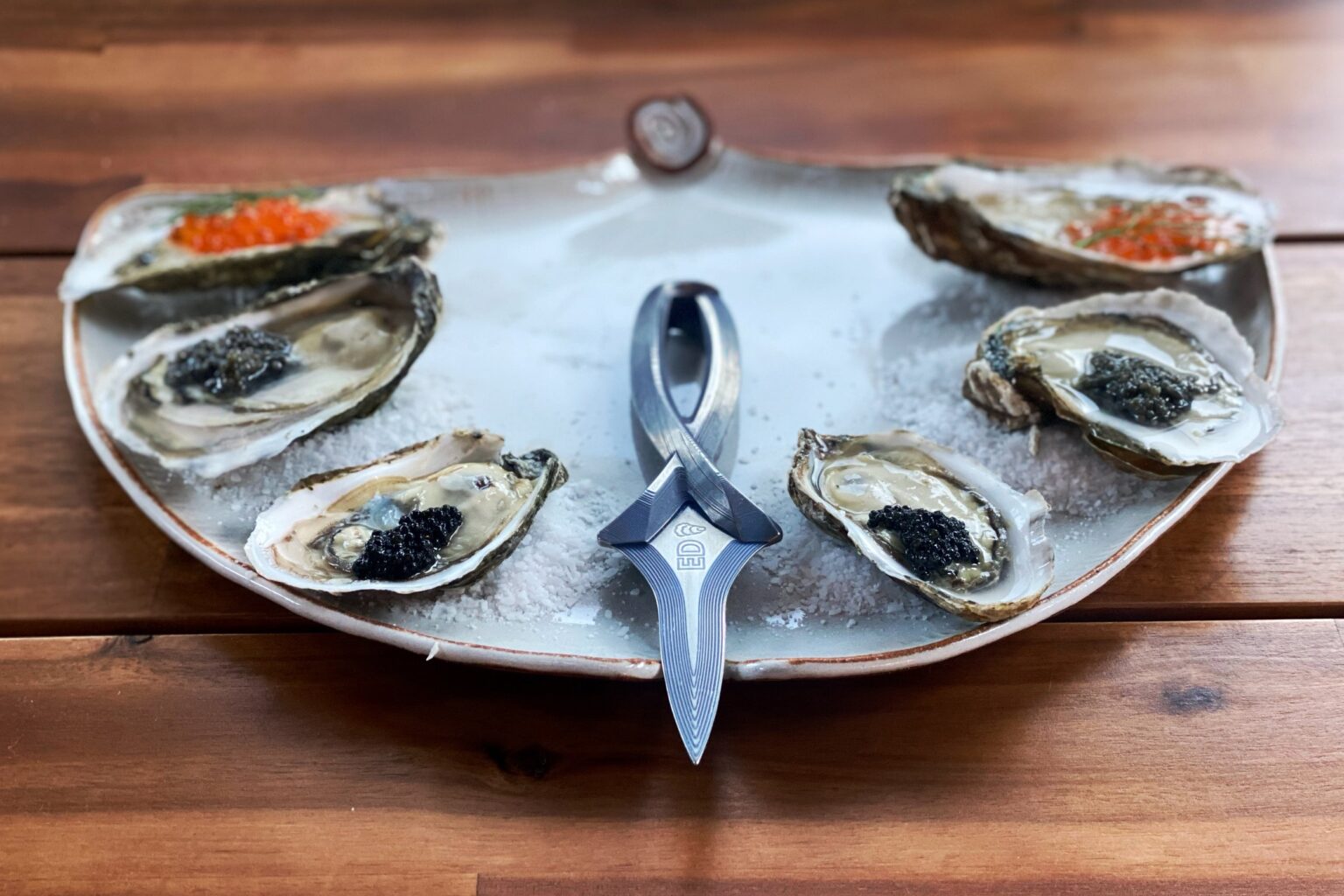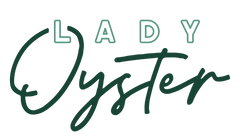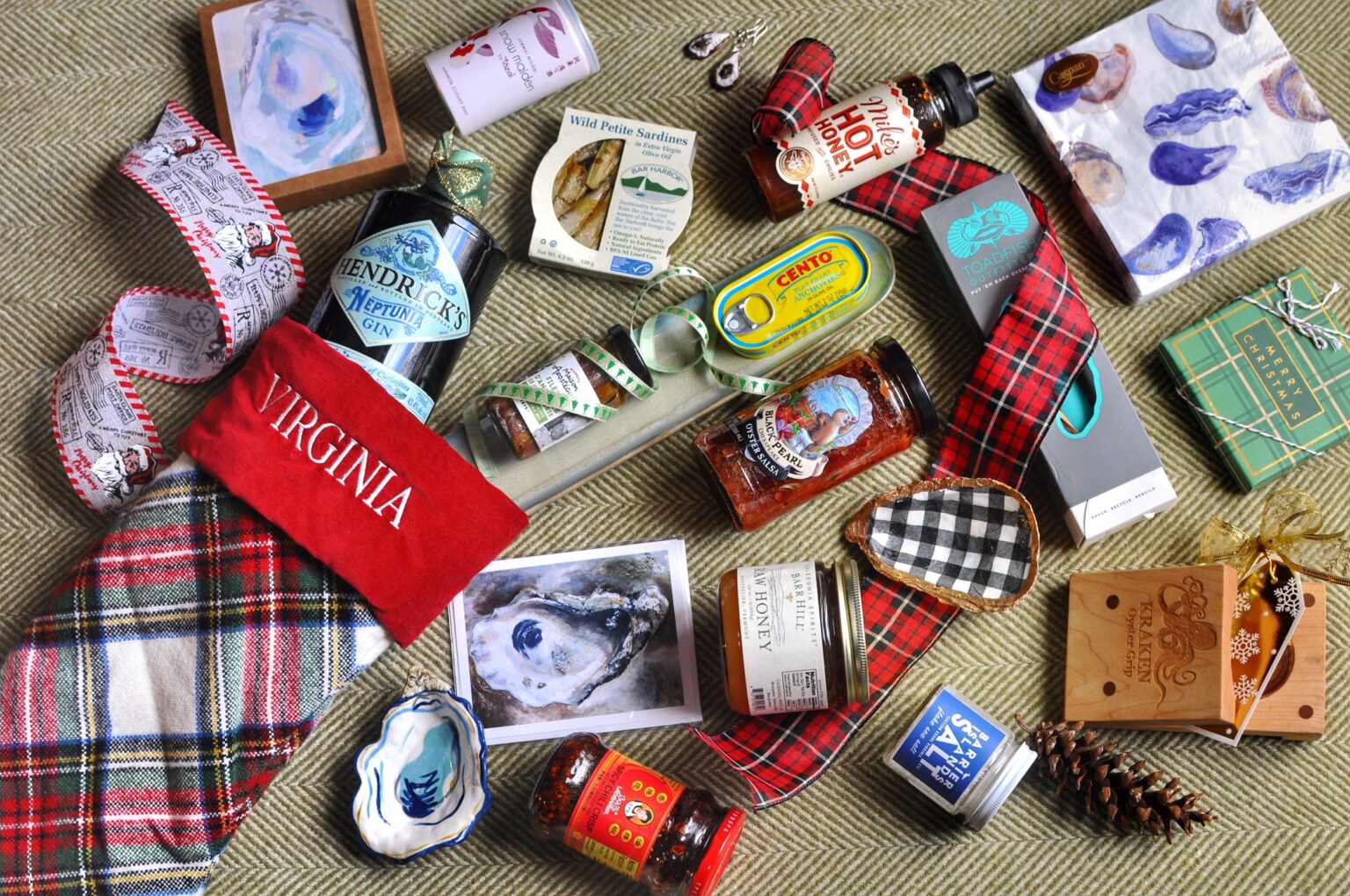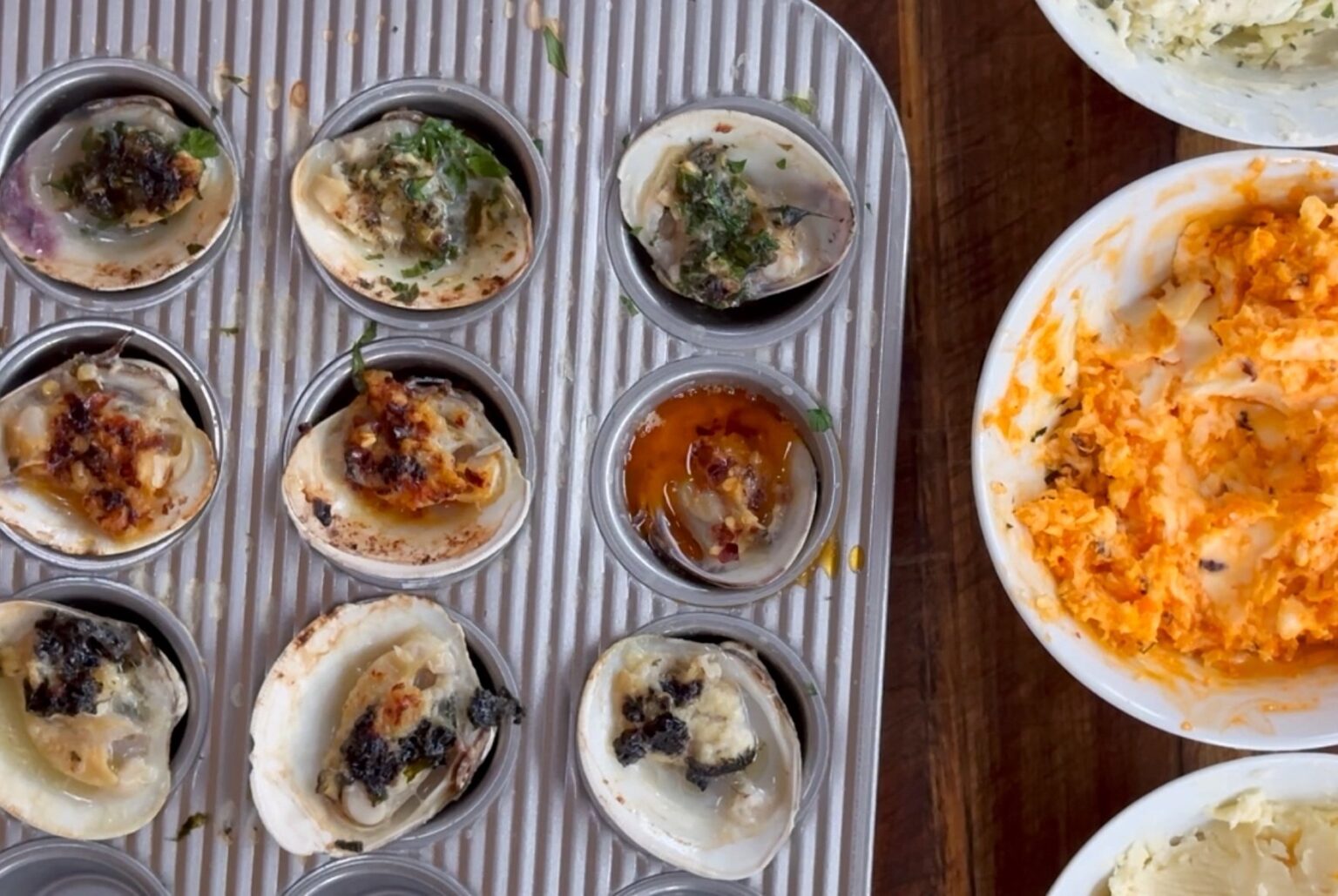Meet the World’s First Full-Titanium Oyster Knife | Made for the New Circular Economy

Five friends and I huddled around the dining room table to open a small package, soon to reveal a sleek wooden box. The engraved lid, held together by four corners of magnets, heeded to light force, and opened with a pop.
We lifted a paper booklet and opened a “welcome” letter about the contents of the box, and a handwritten certificate of authenticity. Underneath it, set deeply and precisely into a wooden inlay, was a titanium oyster knife, peeking out between a microfiber cloth.
“Oohs” and “ahhs” filled the air as I gently pulled the knife from its case. We passed it around and took turns running our fingers down the symmetrical grooves. The blade’s sheen reflected the chandelier above the table, and its illustrious purple lines deepened between the curves that finished in a smooth, central point. It was light and dexterous, but firm and strong. The handle looped like an infinity symbol extending from the blade. I had never seen an oyster knife like it. I rotated the knife with my wrist, flicked it into the air and caught it again. My palm wrapped around its handle, gripping it tightly. I rested my thumb along the flat arc below the blade.
I couldn’t help my awe and wonder. It was made for me.
Alexander Bol is the Founder and Owner of Emergo Designs, a specialty knife company. He resides in Vlissingen, Zeeland, a maritime province in southwestern Netherlands which is known for its traditional oyster aquaculture history, as well as shrimp and mussel fisheries, among other agricultural production. Alexander’s passion for knives—and in particular, oyster knives—is a tribute to his family’s long legacy of shellfish farming in the Eastern Scheldt region. He is also an engineer by trade, so his affinity to symmetry, design, and utility is evident in his craft. I remember checking in with Alexander on the oyster knife and his response being, “I’m not quite happy with it yet.” He’s been working tirelessly on the design and wouldn’t settle for anything less than perfection.
He named his company, “Emergo Designs” to embody the dual meaning of his heritage and workmanship. Zeeland directly translates to “Sea Land.” The region is known for its historic struggle against the sea as a flood plain, and loose soils that frequently change the area’s landscape. The province took the motto, “Luctor et emergo,” meaning, “I struggle and I emerge,” signifying the action of rising above the water’s challenges. Alexander found similar themes of struggle and emergence in his work.
Alexander has spent over a year designing a new oyster knife that improved durability, excelled in design, and provided a sustainable, circular business model. Prior the new “Hugo” which I am so fortunate to possess, he made his knives by hand with wooden molds and metals like steel and aluminum. Alexander would clamp the metal down, scratch out the shape, and start grinding. He’d finish the knives with hand sanded wooden handles and glue. Despite these beautiful and intricate models and customer base across 18 countries, he had his eye on something new… Something more sustainable for his business and his health, but also something with greater longevity and complexity. The next iteration would be an oyster knife carved entirely from a block of pure Titanium.
“It sounds really simple, but I like to complicate things,” he laughed, admittedly.
Chatting with Alexander is like catching up with an old friend. He is kind, passionate, humble, an active listener, and deeply knowledgeable of his craft. Alexander explained to me that Titanium was the perfect material for an oyster knife because it cannot rust, it has unique attributes, and it lasts longer than steel. Titanium is often used in the aerospace and marine industries for its incredible strength, but lightweight nature. If you put all of that together, you get a phenomenal oyster knife that offers both artistry and durability.
He recalled the countless design sketches he had to make. His existing knives had sharp points and hand grips, but he knew that many people preferred to push the knife inside the oyster shell from the hinge, which changed the design dramatically to fit the technique. He began to craft something with a rounder shape, and a more central blade.
“I designed the knife with 3D printing, but it was an evolution. Version 1.1’s blade was too thick, and the handle’s loop didn’t feel right. Then I made the handle shorter and that was a debacle! I went all the way up to version 1.9 to finally get the blade and handle to where I had nothing else to complain about.”
Then came the mechanism to create the knife. His previous method of crafting a knife by hand was a rare skill, but the labor, exposure to dust, and use of chemicals would eventually take a toll on his health. He envisioned avoiding those consequences and making the transition to something sustainable.
“By 2020, I really wanted my oyster knives to be my main income, but to support my family, I knew I had to change things. I couldn’t continue with six hours of hand sanding each day. My hands would eventually fall off and my joints would wear out. If I wanted to provide for my family long-term and beyond the age of 40, I needed to redirect my effort. I also wanted to get rid of dust and chemicals, like glue, solvent, and acetone. This would contribute to a more viable business, and part of that was my own survival too.”
Alexander explained that he had been using a CNC milling machine to carve the wooden boxes he designed for his existing knife merchandise, so he gained a lot of experience in leveraging a computer-controlled process. He knew the potential capabilities that existed if he could incorporate milling into his knife creation, and finally committed to the investment.
“I sold personal items, spent my life savings, and applied for a Circular Grant from the Dutch local government, which was offering funding for the development of sustainable products.”
Sure enough, Alexander secured the grant. But to do that, he had to fully commit to a circular model where no environmentally harmful materials were involved, as well as a recycling program that reused the materials should a customer wish to dispose of the product.
“I no longer use any glues, chemicals, or plastics. My knives go through anodizing with just electricity, salt, and soda (anodizing is a process that oxidizes metal and coats its surface to increase thickness of the finished product and increases wear resistance). It’s harder to achieve the results I want, but I made that commitment. I also have a full recycling program that issues customers a materials certificate for money back when disposing of the knives, and we offer to pay for the shipping to return it to us so we can ensure the materials are reused.”
The entire process is a perfect match for oysters, where a sustainable product meets an equally sustainable food source. In the booklet that arrives with the knife, Alexander fully explains where his knife fits into the circular economy by means of production, use, and recycling. His goal is to move away from cheaply sourced materials and a throwaway culture, and rather towards products that “keep the oceans clean. No more knives with plastic handles…” The rest of the booklet contains the certificate of authenticity, how to shuck an oyster, recycling information, an explanation of Grade 5 titanium,the story of Emergo Designs, maintenance of the knife, and the five year warranty he promises.
In addition to the knife’s circular life cycle, Alexander had other intentions for the Hugo. He knew that many of his previous knives were bought as gifts, and this was a clear indication of the value he wanted to preserve in his products.
“You want it to be pretty and of quality because you want people to purchase it for special reasons. I want my knives to be seen as an heirloom piece. Perhaps something that a family member loved to use. Something that’s passed down. This continues to be my vision for the knives.” His intention is indicative of the time, precision, and care he puts into each individual purchase. It’s a higher retail price point, but entirely worth it for the quality and passion behind the knife.
Alexander’s story now brings me to my Hugo oyster knife. Knife No. 3.
I had the rare opportunity of seeing every step of my own knife’s evolution, thanks to collaborating on the Hugo’s launch. Alexander began by milling the knife out of a solid block of titanium. He then hand-finished it with sanding work to make sure it was equally perfect at all angles. Afterwards, it went into a tumbler to smooth the edges (a process I found very relatable to that of an oyster farm!). When Alexander finally reached out to me to ask me for my favorite color for the knife’s grooves, I humbly asked for purple. Luckily, that was a doable option in the natural anodizing process.
Here are a few progress photos, and check out the full video below!





So what exactly is anodizing, you ask? To add a dye to the Titanium knife, Alexander places the knife into a bucket with soda and water, and then runs an electric current through it. That current then forms a titanium oxide layer, and if you give it long enough, you’ll naturally hit the color purple. That dye will continue to serve as a thick layer of protection when I use it to shuck oysters… Science is so cool.
As you examine the photographs, you’ll see that the purple color finds its way into each line in the knife, which looks like a series of tiny steps that ultimately result in nice round curves. The knife was then polished to silver, creating a two-tone finish.
The result? An agile blade that is not only a long-lasting shucking utility, but pure art. A few shuckers in the Netherlands, including the famous André Linting of Oester Kraker, has shucked over 1,200 oysters to-date without any damage to the latest version.
To test it out, I shucked a handful of Wellfleets, a classic Massachusetts-cultivated Eastern Oyster (c. virginicas) found on oyster bar menus up and down the East Coast of the United States. The Hugo’s fine tip helped give way to the oyster’s hinge faster than the more rounded blades normalized in a New Haven or Dexter-Russel. The lack of an angled upward tip didn’t change the outcome of the oyster shuck, in part due thanks to the edgy grooves in the knife that added to the durability of the blade entering the oyster.
I found that the “steps” in the knife aided in swiftly slicing off the top shell because of the friction of the grooves against the calcium carbonate. Due to titanium’s durability, the shell’s corrosiveness and chaotic formation was less concerning for this sturdy metal, which was able to align with the top shell and slice through the adductor with one fell swoop. Some tiny shell fragments found their way into the lines of the knife (as seen in a few of the photos) but can be quickly cleaned with the wipe of a towel.
My shucks were clean and fresh. The handle was strong and less flimsy than plastic or wooden alternatives. Because the knife is one single piece of titanium, its strength provided confidence to the shuck, despite having a narrower point (as a good reminder, please always wear gloves while shucking!). My thumb had a relaxing place to rest and offered additional force as needed. I felt very flexible in my handling, and soon discovered that the blade could bravely scrape along the bottom of the shell for a single clean detachment.
After my initial awe and successful oyster plating, I knew that this knife would become so much more than the heap of others I’ve kept in rotation. It would become a keepsake, representing a memory of my own love for oysters, a symbol of sustainable choices, an intrinsic value of passion and craftsmanship, and the ongoing reminder that oysters continue to inspire innovation, even in the most basic of utilities.
If you are interested in purchasing your own, Alexander’s shop for the Hugo has just launched, which makes this story so exciting to share. Thank you, Alexander, for going on this oyster knife journey and imparting more creativity into this world! Personally, I thank you for entrusting me to share your phenomenal product and talent.
You can also follow Emergo Designs and Alexander’s knife making journey on Instagram and Facebook.























